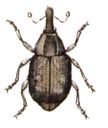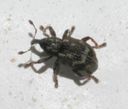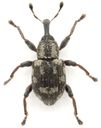Duckweed Weevil
Tanysphyrus lemnae
Classification
- Phylum: Arthropoda
- Subphylum: Hexapoda
- Class: Insecta
- Order: Coleoptera
- Suborder: Polyphaga
- Superfamily: Curculionoidea
- Family: Brachyceridae
- Subfamily: Erirhininae
- Genus: Tanysphyrus
- Species: lemnae
Pronunciation
How to pronounce Tanysphyrus lemnae: //ˈtæn.ɪsˌfaɪ.rəs ˈlɛmˌneɪ//
These audio files are automatically generated. While they are not always 100% accurate, they are a good starting point.
Images





Summary
Tanysphyrus lemnae, known as the Duckweed Weevil, is a small weevil that mines the leaves of duckweed. It is found in North America and Europe and is associated with aquatic habitats.
Physical Characteristics
Tanysphyrus lemnae is a small weevil, approximately 1.2 mm in length.
Identification Tips
Identification can be made by examining its size and association with duckweed, as well as potential morphological features specific to the Erirhininae subfamily.
Habitat
Typically found in aquatic environments where duckweed (Lemna spp.) is abundant.
Distribution
Native to Europe and North America; it's also considered to be a holarctic species.
Diet
Larvae are leaf-miners that feed on duckweed plants.
Life Cycle
The life cycle of Tanysphyrus lemnae includes an aquatic larval stage, where they mine the leaves of duckweed.
Reproduction
Details on reproduction are not specified, but generally, weevils lay eggs on or near their host plants.
Ecosystem Role
Plays a role in aquatic ecosystems as a herbivore, potentially influencing duckweed populations.
Tags
- Weevil
- Duckweed
- Aquatic Insect
- Holarctic Species